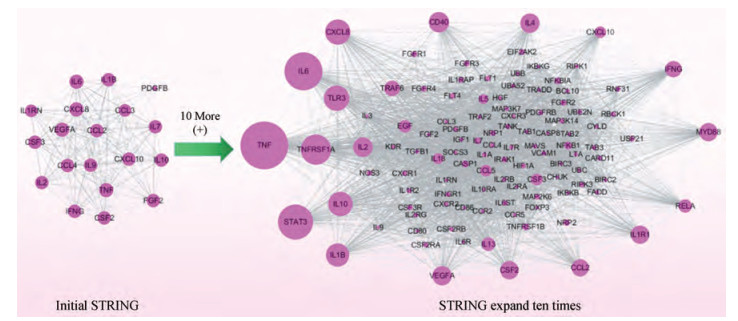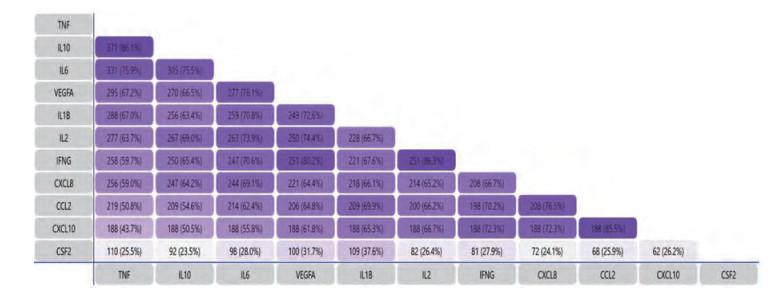2. 南京中医药大学附属苏州市中医医院, 江苏 苏州 215009;
3. 苏州市吴门医派研究院, 江苏 苏州 215009;
4. 南京中医药大学药学院, 江苏 南京 210023
2. Suzhou TCM Hospital Affiliated to Nanjing University of Chinese Medicine, Suzhou 215009, China;
3. Suzhou Academy of Wumen Chinese Medicine, Suzhou 215009, China;
4. School of Pharmacy, Nanjing University of Chinese Medicine, Nanjing 210023, China
截止2020年3月17日, 新型冠状病毒肺炎(Coronavirus Disease 2019, COVID-19)已造成中国8万余人确诊感染, 2千余例重症患者, 3千多人死亡[1], 并且该病毒已在全世界蔓延[2]。此次COVID-19造成的经济损失以及严重程度远远超过近几年发生的中东呼吸综合症(Middle East respiratory syndrome, MERS)和严重急性呼吸综合征(severe acute respiratory syndrome, SARS)。Wang等[3]对138例住院新冠肺炎患者的数据分析显示, 新冠肺炎致死患者中性粒细胞增多, 可能与病毒入侵细胞时引起的细胞因子风暴(cytokine storm, CS)有关。近期的临床研究[3-5]分析了COVID-19患者的临床特征, 均发现肺炎患者, 特别是重症肺炎患者的淋巴细胞计数显著降低, 众多炎症因子如白介素-6 (IL-6)和肿瘤坏死因子(TNF)等显著增高。事实上, 在SARS和MERS等病毒感染的后期, CS也是很多患者最终死亡的主要原因[6]。也就是说, CS始终是冠状病毒及其他严重感染患者疾病进展及死亡的重要推手之一。国家卫生健康委员会、国家中医药管理局最新印发的《新型冠状病毒感染的肺炎诊疗方案(试行第七版)》 (简称第七版诊疗方案)显示[7], COVID-19患者以肺脏和免疫系统损害为主, 其他脏器因基础病不同而不同, 多为继发性损害。
CS即细胞因子释放综合征(cytokine release syndrome, CRS), 又称高细胞介质症(hypercytokinemia), 是由感染、药物或某些疾病引起的免疫系统过度激活, 体内的细胞因子平衡被打破, 促炎性细胞因子持续大量产生, 不断活化更多的免疫细胞聚集到炎症部位。过多的免疫细胞及多种促炎细胞因子会引起组织充血、水肿、发热和损伤, 还可能引起其他继发性感染甚至导致“全身炎症反应综合征”(脓毒败血症), 使患者因多器官衰竭而死亡[8]。魏海明团队[9]对33例新冠肺炎患者血液30项免疫学指标的全面分析, 发现了新型冠状病毒感染致重症肺炎CS关键机制:新型冠状病毒感染后, 迅速激活病原性T细胞, 产生粒细胞-巨噬细胞集落刺激因子(granulocyte-macrophage colony stimulating factor, GM-CSF)和IL-6等因子。GM-CSF进一步激活CD14+CD16+炎症性单核细胞, 产生大量的IL-6和其他炎症因子, 从而形成炎症风暴, 导致严重的肺部和其他器官的免疫损伤(图 1)。因此, IL-6和GM-CSF是引发新冠肺炎患者CS的两个关键炎症因子。

|
Figure 1 A hypothetical cytokine storm caused by severe acute respiratory syndrome coronavirus 2 (SARS-CoV-2) invasion invading the lung and multiple organ failure induced by Coronavirus Disease 2019 (COVID-19) and the intervention of the traditional Chinese medicine systems pharmacology database and analysis platform (TCMSP) database. AHF: Acute heart failure; ARF: Acute renal failure; IL: Interleukin |
目前, 针对CS治疗, 第七版诊疗方案采用糖皮质激素作为免疫抑制剂, 用于遏制重症患者的免疫激化反应, 但是糖皮质激素的使用可能会造成二次感染、病程延长等不良反应, 且存在严重后遗症风险[10]。诊疗方案中增加了血液净化对重型、危重型患者清除炎症因子, 阻断CS, 从而减轻炎症反应对机体的损伤。由此可见, 针对CS进行对症治疗或将成为重症患者的一线希望。中医认为COVID-19属于“疫病”范畴, 源于感受疫疠之气、湿毒犯肺, 基本病机特点为“湿、热、毒、瘀、虚”[11]。既往的药理学研究[12]表明, 中药在清除抗原、调节免疫和保护组织等方面都发挥着重要作用, 且中医药被广泛用于此次COVID-19的治疗中, 本文将针对临床报道的与CS相关的生化指标, 通过中药系统药理学数据库和分析平台(TCMSP)挖掘作用于细胞因子的中药, 为临床选方、加减用药以及新药开发提供参考。
材料与方法资料来源 以COVID-19、Coronavirus Disease 2019、2019-nCoV、2019 Novel Coronavirus、CS和临床特征(clinical characteristics)组合检索中国知网和PubMed等数据库中相关信息, 纳入有关COVID-19患者的细胞因子相关的临床研究文献, 截止日期为2020年3月17日下午17点。
数据库和软件 数据库包括TCMSP[13] (http://tcmspw.com/tcmsp.php, 版本: 2.3)、人类基因数据库(Gene Cards)[14] (https://www.genecards.org, 版本: 4.13)、蛋白质靶点数据库(Uniprot)[15] (https://www.uniprot.org)和功能蛋白关联网络数据库(STRING)[16] (https://string-db.org, 版本: 11.0);分析软件包括网络分析工具(Cytoscape)[17] (版本: 3.7.2)。
中药成分收集 借助TCMSP, 以搜集到的相关细胞因子为关键词检索作用于细胞因子的中药及单体化合物。
靶点-网络的构建 运用STRING数据库分析细胞因子作用靶点之间关系进而使用Cytoscape进行可视化分析, 通过度(Degree)值大小评价PPI网络中蛋白质关系强弱。
初步验证 将数据库筛选得到的中药结合目前诊疗方案中所用的中药交集, 得出共性中药, 再通过文献检索各味中药作用于细胞因子的既往实验研究从而佐证本结果的合理性。
结果 1 COVID-19相关的细胞因子的收集截至3月17日, 共检索得到与COVID-19相关的细胞因子19个, 比SARS (10个)和MERS (4个)多, 见表 1[4, 5, 9, 18-23]。由此可见, 本次的新冠病毒更容易激发CS, 且涉及的细胞因子更广泛, 更容易导致人体的多器官衰竭。
2 靶点确认和中药筛选| Table 1 Changes of cytokine storm index caused by coronavirus. SARS-CoV: Severe acute respiratory syndrome coronavirus; MERS-CoV: Middle East respiratory syndrome-related coronavirus; IFNγ: Interferon gamma; IP-10: Interferon gamma-induced protein 10; MCP1: Monocyte chemotactic protein-1; TNFα: Tumor necrosis factor α; Basic FGF: Basic fibroblast growth factor; GCSF: Granulocyte colony stimulating factor; GM-CSF: Granulocyte-macrophage colony-stimulating factor; MIP1A: Macrophage inflammatory protein 1 alpha; PDGF: Platelet derived growth factor; VEGF: Vascular endothelial growth factor |
将上述得到的19个细胞因子通过Uniprot校正基因名, 在TCMSP数据库搜索作用于19个细胞因子的中药, 发现多种中药作用于同一个细胞因子, 见表 2。分析该部分数据发现, 中药多成分治疗疾病是通过多靶点发挥疗效的, 且针对特定的细胞因子合理的加减用药, 以及优化处方可能会增强中药复方治疗新冠肺炎的疗效。
| Table 2 Basic information of 19 cytokines and the role of traditional Chinese medicine (TCM). TCMSP: Traditional Chinese medicine systems pharmacology database and analysis platform |
将查询得到的19个靶点带入STRING数据库, 结果发现19个靶点的度值并没有明显的差异, 故采用数据库中的拓展功能将靶点相互作用网络拓展10次。通过Cytoscape软件中可视化(图 2)。细胞因子作用靶点相互作用网络拓扑学分析, 见表 3 (度值≥ 70)。经Network Analyzer分析网络拓扑学属性发现, 靶点相互作用网络包含109个节点、2 419条边, 其中节点表示靶点, 每条边则表示靶点与靶点之间的相互作用关系, 靶点越大表示关联度越强, 其中平均节点度为44.39, 从中可以发现TNF和IL-6在网络中占主导作用。

|
Figure 2 The interaction of 19 cytokines after 10 times of expansion |
| Table 3 Network topology analysis after 10 times expansion of cytokine targets (Degree ≥ 70). STAT3: Signal transducer and activator of transcription; TNFRSF1A: Tumor necrosis factor receptor superfamily; TLR3: Toll-like receptors |
网络药理学表明, 中药可以通过多成分、多靶点和多途径发挥药效作用。由于作用于后8种细胞因子的中药太少(表 2), 因此取作用于前11个细胞因子的中药求交集, 结果发现共有62种中药作用于11个细胞因子(图 3); 再结合2015版《中国药典》记录的归肺经的标准进行筛选, 结果共得到包括麻黄在内的22种中药(表 4)。

|
Figure 3 Distribution and intersection of traditional Chinese medicines acting on cytokines |
| Table 4 Basic information of TCMSP of 22 intersection traditional Chinese medicines |
Wang等[24]对新型冠状病毒肺炎中医药诊治方案综合分析得出, COVID-19进展期多为“湿郁化热, 热毒损肺”, 治疗上以宣肺通腑、清热解毒为主, 攻下泻热以助肺气宣降。本文筛选得到的22种中药中麻黄、甘草、金银花、连翘和虎杖在新型冠状病毒肺炎诊疗方案的推荐处方中, 其作用于细胞因子的既往实验研究见表 5[25-33]。从中可以发现, 数据库筛选得到的结果不仅与当前《新型冠状病毒感染的肺炎诊疗方案》中推荐的中药种类相吻合, 而且既往的研究也表明这些中药或其有效成分的确可以作用于细胞因子发挥疗效。因此, 借助于细胞因子在TCMSP数据库中筛选的中药可以为临床处方优化及治疗提供参考。
| Table 5 Previous experimental studies on the effects of traditional Chinese medicine on cytokines |
由上述分析结果可以看出, TNF和IL-6在CS中起着关键的作用, 第七版诊疗方案已经明确将IL-6水平上升作为病情恶化的临床警示指标。大量的研究[34]证实, IL-6激活免疫细胞(T细胞和巨噬细胞), 清除感染病毒的细胞, 是CS中的主力, 第一级细胞因子称为“初级风暴”, 初级细胞因子可以进一步招募并激活效应细胞及其他细胞, 如CD8+ T细胞、自然杀伤细胞(natural killer cell, NK)、调节性T细胞(regulatory cell, Treg)和辅助型T细胞2 (T helper 2 cell, Th2), 这些细胞还会分泌第二级细胞因子(次级细胞因子IFNγ和IL-10等), 继续病毒清除过程, 抑制炎症, 并试图恢复肺功能。致命的往往是第二级风暴, 这时细胞因子水平已超出清除病毒所需, 造成过多的炎性细胞聚集。如果大量炎症细胞聚集在肺泡内, 将导致氧合功能下降, 造成呼吸衰竭。基于以上研究分析, 作者认为针对CS治疗应该在病情中期进行, 一旦病情恶化进入第二级风暴阶段将很难医治。
中医药在此次疫情中发挥着重要作用, 第七版诊疗方案中在疾病发展的不同阶段分别给予了不同的中药复方, 从中体现了中医理论中“辨证论治”的重要性, 如:麻黄出现在进展期的中药处方中, 甘草出现在早、中、重期的处方中等[24]。通过数据库及文献挖掘发现, 多种中药对不同的细胞因子都具有治疗作用, 这也体现了中药多靶点、多层次的作用特点。目前, 国家及各地方的诊疗方案中, 均将中西医结合的方式作为COVID-19临床治疗方案, 尤其是靶向药物在临床上收效良好[35], 这提示某些具有特定功效的中药也可以在针对不同阶段病情处方优化时进行相加减。本文根据“湿毒犯肺”的中医理论和TCMSP数据库筛选出作用于细胞因子风暴的相关中药, 并进一步探讨了5种应用最多的中药的既往研究情况, 以期为防治重症肺炎患者产生的CS进行处方优化以及后续的新药开发提供理论参考。
| [1] |
National Health Commission of the People's Republic of China. Up to 24 March 17th novel coronavirus pneumonia epidemic situation[EB/OL]. 2020[2020-03-17]. http://www.nhc.gov.cn/xcs/yqtb/list_gzbd.shtml.
|
| [2] |
Bogoch II, Watts A, Thomas-Bachli A, et al. Potential for global spread of a novel coronavirus from China[J]. J Travel Med, 2020. DOI:10.1093/jtm/taaa011 |
| [3] |
Wang D, Hu B, Hu C, et al. Clinical characteristics of 138 hospitalized patients with 2019 novel coronavirus-infected pneumonia in Wuhan, China[J]. JAMA, 2020. DOI:10.1001/jama.2020.1585 |
| [4] |
Huang C, Wang Y, Li X, et al. Clinical features of patients infected with 2019 novel coronavirus in Wuhan, China[J]. Lancet, 2020. DOI:10.1016/S0140-6736(20)30183-5 |
| [5] |
Fang Y, Zhang H, Xu Y, et al. CT manifestations of two cases of 2019 novel coronavirus (2019-nCoV) pneumonia[J]. Radiology, 2020. DOI:10.1148/radiol.2020200280 |
| [6] |
Younan P, Iampietro M, Nishida A, et al. Ebola virus binding to Tim-1 on T lymphocytes induces a cytokine storm[J]. mBio, 2017. DOI:10.1128/mBio.00845-17 |
| [7] |
The diagnosis and treatment plan for 2019-nCoV (the seventh trial edition)[EB/OL]. http://www.nhc.gov.cn/yzygj/s7653p/202003/46c9294a7dfe4cef80dc7f5912eb1989.shtml.
|
| [8] |
Shimabukuro-Vornhagen A, Gödel P, Subklewe M, et al. Cytokine release syndrome[J]. J Immunother Cancer, 2018, 6: 56. DOI:10.1186/s40425-018-0343-9 |
| [9] |
Zhou YG, Fu BQ, Zheng XH, et al. Pathogenic T cells and inflammatory monocytes incite inflammatory storm in severe COVID-19 patients[J]. Nat Sci Rev, 2020. DOI:10.1093/nsr/nwaa041 |
| [10] |
Caplan A, Fett N, Rosenbach M, et al. Prevention and management of glucocorticoid-induced side effects:a comprehensive review[J]. J Am Acad Dermatol, 2017, 76: 1-9. DOI:10.1016/j.jaad.2016.01.062 |
| [11] |
Xiang Q, Mo ZB, Song EF. Traditional Chinese medicine theory and clinical study on novel coronavirus pneumonia infection[J]. Herald Med (医药导报), 2020. http://kns.cnki.net/kcms/detail/42.1293.R.20200212.2049.002.html.
|
| [12] |
Yin MX, Cao Y, Shi CY, et al. Research progress on prevention and treatment of cytokine storm with traditional Chinese medicine[J]. Chin Herb Med (中草药), 2020. http://kns.cnki.net/kcms/detail/12.1108.R.20200227.1610.002.html.
|
| [13] |
Ru J, Li P, Wang J, et al. TCMSP:a database of systems pharmacology for drug discovery from herbal medicines[J]. J Cheminform, 2014, 6: 13. DOI:10.1186/1758-2946-6-13 |
| [14] |
Trends M, Chalifa-Caspi V, Prilusky J, et al. GeneCards:integrating information about genes, proteins and diseases[J]. Trends Genet, 1997, 13: 163. DOI:10.1016/S0168-9525(97)01103-7 |
| [15] |
UniProt Consortium T. Uniprot:the universal protein knowledgebase[J]. Nucleic Acids Res, 2017, 45: D158-D169. DOI:10.1093/nar/gkw1099 |
| [16] |
Szklarczyk D, Franceschini A, Wyder S, et al. STRING v10:protein-protein interaction networks, integrated over the tree of life[J]. Nucleic Acids Res, 2015, 43: D447-D452. DOI:10.1093/nar/gku1003 |
| [17] |
Smoot ME, Ono K, Ruscheinski J, et al. Cytoscape 2.8:new features for data integration and network visualization[J]. Bioinformatics, 2011, 27: 431-432. DOI:10.1093/bioinformatics/btq675 |
| [18] |
Gu QH, Li J. SARS produces cytokines and their elimination and antagonism[J]. Dial Artif Organs (透析与人工器官), 2003, 14: 1-9. |
| [19] |
Wong CK, Lam CWK, Wu AKL, et al. Plasma inflammatory cytokines and chemokines in severe acute respiratory syndrome[J]. Clin Exp Immunol, 2004, 136: 95-103. DOI:10.1111/j.1365-2249.2004.02415.x |
| [20] |
Jiang HJ, Xie ZG, Lu M, et al. The expression and significance of cytokines in lung tissue form severe SARS patients[J]. Chin J Histochem Cytochem (中国组织化学与细胞化学杂志), 2007, 16: 259-263. |
| [21] |
Mahallawi WH, Khabour OF, Zhang Q, et al. MERS-CoV infection in humans is associated with apro-inflammatory Th1 and Th17 cytokine profile[J]. Cytokine, 2018, 104: 8-13. DOI:10.1016/j.cyto.2018.01.025 |
| [22] |
Liu J, Li SM, Liu J, et al. Longitudinal characteristics of lymphocyte responses and cytokine profiles in the peripheral blood of SARS-CoV-2 infected patients[J]. medRxiv, 2020. DOI:10.1101/2020.02.16.20023671 |
| [23] |
Wan SX, Yi QJ, Fan SB, et al. Characteristics of lymphocyte subsets and cytokines inperipheral blood of 123 hospitalized patients with 2019 novel coronavirus pneumonia (NCP)[J]. medRxiv, 2020. DOI:10.1101/2020.02.10.20021832 |
| [24] |
Wang CC, Wu S, Jiang LJ, et al. Comprehensive analysis of TCM diagnosis and treatment schemes for COVID-19 in all regions of China[J]. Mod Tradit Chin Med Mater Med World Sci Technol (世界科学技术-中医药现代化), 2020. http://kns.cnki.net/kcms/detail/11.5699.R.20200225.1702.006.html.
|
| [25] |
Xu JH, Cao HR, Chen YX, et al. Effect of Herba Ephedrae or honey-fried Herba Ephedrae alone on airway inflammation of asthmatic rat[J]. J New Chin Med (新中医), 2014, 46: 197-199. |
| [26] |
Wang J, Xiong Y, Xiong B, et al. Effects of aerosolized aqueous extract of ephedra on airway inflammation in asthmatic mice[J]. Chongqing Med (重庆医学), 2013, 42: 304-307. |
| [27] |
Zhang JF, Zeng G, Li CQ, et al. Effects of diammonium glycyrrhizinate on the patients with acute lung injury[J]. Chin J Critical Care Med (中国急救医学), 2011, 31: 646-648. |
| [28] |
Guan Y, Xie QM. Regulation of licorice flavonoids on cytokines mRNA expression and oxidation reaction in mice with lung inflammation[J]. Chin Herb Med (中草药), 2009, 40: 1254-1259. |
| [29] |
Tang LP, Li WH, Yuan S, et al. Effects of honeysuckle extract on acute lung injury induced by lipopolysaccharide in rats[J]. Livestock Poul Ind (畜禽业), 2019(10): 1-3. |
| [30] |
Wang H, Chi Q, Xiong SL, et al. Effects of Lonicera japonica extract on lung inflammation in LPS-induced ARDS rats[J]. J Guangdong Pharm Univ (广东药科大学学报), 2017, 33: 379-382. |
| [31] |
Liu ZH. Screening of Chinese Herbs against Actinobacillus pleuropneumoniae Infection and Its Effect on Infected Animals (抗猪传染性胸膜肺炎放线杆菌感染的中药筛选及其对感染动物的治疗效果)[D]. Changchun: Jilin University, 2018.
|
| [32] |
Chu W. Effect and significance of polygonum cuspidatum on inflammatory factors in diabetic rats[J]. Chin Foreign Med Res (中外医学研究), 2012, 10: 143-144. |
| [33] |
Li M, Wang B, Meng JG, et al. Effect of Polygonum cuspidatum extract on gene expression of inflammatory factors by human periphera[J]. Pharmacol Clin Chin Mater Med (中药药理与临床), 2012, 28: 74-77. |
| [34] |
Guo XJ, Thomas PG. New fronts emerge in the influenza cytokine storm[J]. Semin Immunopathol, 2017, 39: 541-550. DOI:10.1007/s00281-017-0636-y |
| [35] |
Liu QY, Wang XL. Strategies for the development of drugs targeting novel coronavirus 2019-nCoV[J]. Acta Pharm Sin (药学学报), 2020, 55: 349-354. |
 2020, Vol. 55
2020, Vol. 55


